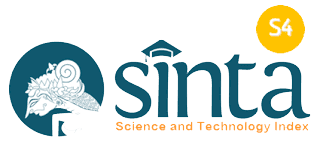The Influence of Internal Communication and Work Discipline on Employee
(1) Pamulang University, South Tangerang, Banten, Indonesia
(*) Corresponding Author
DOI: https://doi.org/10.26858/pdr.v1i1.20519
Abstract
This study empirically tests whether internal communication and work discipline are applied to realize employee performance at PT. Duta Putra Sejahtera, Jakarta. This study uses a qualitative descriptive method with data collection techniques, namely observation, and distribution of questionnaires/questionnaires. The data analysis techniques used were validity and reliability tests, classic assumption tests (normality test, heteroscedasticity, and multicollinearity tests) along with multiple linear regression analysis, and simple linear regression analysis that was processed using SPSS 20. Sixty-five respondents using the saturated sample method. Internal communication significantly affects employee performance with a significant figure of 0.000 <0.05 and t count 11.911> t table 1.669. Work discipline significantly affects employee performance with a significant number of 0.751 <0.05 and t count -0.319> t table 1.669. The effect of Internal Communication (X1) and Work Discipline (X2) on Employee Performance (Y) has a significant effect simultaneously. It can be seen that the f count is with a significant level of 0.000 <0.05, then the degree of freedom (df) is (k-1) or the degree of the numerator and (NK) for the degree of denominator where n = number of observations and k = the number of variables, the obtained F table is 3.99 so that the value of f count is greater than the table (242.696> 3.99). Thus the test results show that Ho is rejected and Ha is accepted. It indicates that together (simultaneously), the independent variables (internal communication and work discipline) have a significant effect on the dependent variable (performance).
Keywords
Full Text:
PDFReferences
Dessler, G. (2016). Manajemen Sumber Daya Manusia. Jakarta: Jilid 1 Edisi 10, Alih Bahasa: Paramita Rahay.
Erlangga, H. (2019). The Meaning, Benefit, and Importance of Development Entrepreneurship in Higher Education. Asian Journal of Contemporary Education, 3(2), 105-110.
Ghozali, I. (2013). Analisis Multivarate dengan program SPSS. Edisi Ketujuh.Semarang: Badan Penerbit Universitas Diponegoro.
Pratiwi, N. J., Jamaluddin, J., Niswaty, R., & Salam, R. (2019). The Influence of Work Facilities on Employee Performance at the Regional Financial Management Agency Secretariat Section of South Sulawesi Province. Jurnal Ad’ministrare, 6(1), 35–44.
Ruliana, P. (2016). Komunikasi Organisasi Teori dan Studi Kasus edisi kedua. Jakarta: PT. Raja Grafindo Persada.
Saggaf, M. S., & Salam, R. (2017). Examining Academic Service using Importance Performance Analysis (IPA).
Sugiyono. (2017). Metode Penelitian Kuantitatif, Kualitatif, dan R&D. Bandung: Alfabeta.
Sunarsi, D. (2018). Pengaruh Gaya Kepemimpinan dan Disiplin Kerja Terhadap Kinerja Karyawan Pada CV. Usaha Mandiri Jakarta. JENIUS (Jurnal Ilmiah Manajemen Sumber Daya Manusia), 1(2).
Supomo, R, & Nurhayati, E. (2018). Manajemen Sumber Daya Manusia. Bandung: Yrama Widya.
Sutrisno, E. (2016). Manajemen Sumber Daya Manusia. Jakarta: Kencana.
Suwanto, S. (2019). Pengaruh Disiplin Kerja dan Motivasi Kerja Terhadap Kinerja Karyawan Pada Rumah Sakit Umum Tangerang Selatan. JENIUS (Jurnal Ilmiah Manajemen Sumber Daya Manusia), 3(1), 16-23.
Suwanto, S. (2019). Pengaruh Gaya Kepemimpinan dan Lingkungan Kerja Terhadap Kinerja Karyawan Unit Telesales Pada PT BFI Finance Indonesia Tbk. Jurnal Ekonomi Efektif, 1(2).
Zainal, H., Parinsi, W. K., Hasan, M., Said, F., & Akib, H. (2018). The influence of strategic assets and market orientation to the performance of family business in Makassar City, Indonesia. Academy of Strategic Management Journal, 17(6).
Article Metrics
Abstract view : 144 times | PDF view : 30 timesRefbacks
- There are currently no refbacks.
Copyright (c) 2020 Suwanto Suwanto


































